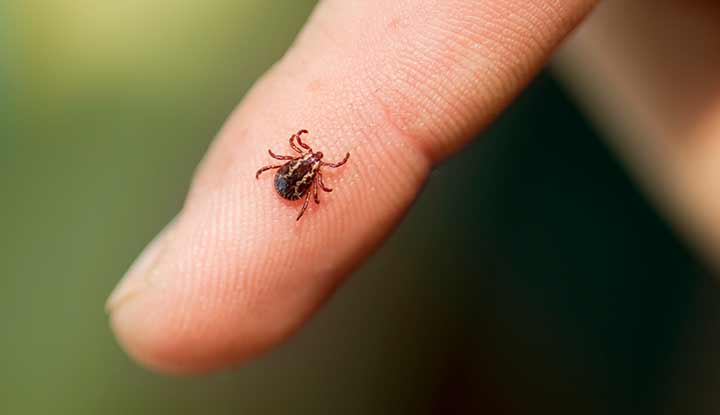Babesiosis is a disease you get from the bite of a tick infected with the parasite Babesia. It causes flu-like symptoms and can lead to severe illness. You’re at higher risk for life-threatening illness if you have a weakened immune system or don’t have a functioning spleen. Combinations of antiparasitics and antibiotics treat babesiosis.
Advertisement
Cleveland Clinic is a non-profit academic medical center. Advertising on our site helps support our mission. We do not endorse non-Cleveland Clinic products or services. Policy

Babesiosis (pronounced “buh-BEE-zee-oh-sis”) is an illness you get from many species (types) of the parasite Babesia. You can get it through the bite of infected blacklegged ticks or from an organ transplant.
Advertisement
Cleveland Clinic is a non-profit academic medical center. Advertising on our site helps support our mission. We do not endorse non-Cleveland Clinic products or services. Policy
Babesiosis usually causes flu-like symptoms. But the parasite’s destruction of red blood cells can lead to life-threatening complications, especially if you have a weakened immune system. A common complication is hemolytic anemia, a condition where your red blood cells are destroyed faster than you can make new ones.
You can get babesiosis in places where Babesia parasites and the ticks that carry them are found together. These areas are in the U.S., Europe and Asia. In the U.S., it’s mostly found in the Upper Midwest and Northeast, with a few cases on the West Coast. It’s most common in seven states:
Babesiosis is rare, with fewer than 3,000 cases reported in the U.S. each year. But it’s considered an emerging infectious disease, which means the number of cases has increased in recent years.
Symptoms of babesiosis start one to four weeks after exposure. They include:
About 1 in 4 people have no symptoms of babesiosis. Unlike other tick-borne diseases, it usually doesn’t cause a rash.
Severe babesiosis may cause additional symptoms, including:
Advertisement
Weight loss isn’t a common sign of babesiosis. But if you don’t feel like eating or are feeling sick to your stomach and vomiting, you might lose weight.
Several types of Babesia parasites cause babesiosis. Babesia are protozoa, one-celled organisms that are too small to see without a microscope. They get into your blood through a tick bite. There, they infect and destroy your red blood cells. In mild cases, this can make you tired. In severe cases, like if you have a compromised immune system, the infection can cause life-threatening complications.
B. microti is the most common cause of symptomatic babesiosis in the U.S. Other Babesia species that sometimes make you sick include B. duncani, B. divergens, B. venatorum and B. crassa.
Babesiosis spreads from animals to humans when a tick bites an infected animal — usually a small rodent, like a mouse — and then bites you. The parasite infects your blood cells and reproduces there.
In the U.S., the blacklegged tick (Ixodes scapularis) is the most common carrier of the parasite that causes babesiosis. Blacklegged ticks carry many other illnesses, including Lyme disease and anaplasmosis. It’s often called a “deer tick,” though deer usually don’t carry babesiosis. In Europe, castor bean ticks (I. ricinus) transmit Babesia.
You can also get babesiosis from a blood transfusion. This happens when a blood donor is infected without knowing it.
No, babesiosis isn’t contagious from person to person. Rarely, Babesia is transmitted from a pregnant women to the fetus.
Babesiosis is most common in the spring and summer. This is because young ticks (nymphs) come out in the spring and are more likely to spread Babesia than adult ticks.
Nymphs are small (about the size of a poppy seed) and can be hard to see. They grow into adults during the summer. You can still get babesiosis from an adult tick, but they’re easier to see, and you’re more likely to remove them before they bite you.
While anyone can get babesiosis, you’re at higher risk for getting severely ill if you:
Babesiosis can cause life-threatening complications, especially if you have a weakened immune system. They include:
Advertisement
Blood tests diagnose babesiosis. Your healthcare provider will give you a physical exam and ask about your symptoms and health history. Let them know if you’ve recently (within the past three weeks) been in an area where you could’ve been bitten by a tick, even if you don’t remember being bitten. It’s also important for them to know if you’ve had a blood transfusion in the past six months.
If your provider thinks you could have babesiosis, they’ll order tests to look for parasites in your blood. They’ll also rule out other illnesses that can cause similar symptoms.
Your provider can treat babesiosis with a combination of medications. These include antiprotozoals, antibiotics and antimalarial drugs. They might give them to you through an IV in your arm or in pill or liquid form for you to swallow.
If you’re very sick, you may need other procedures, like a blood transfusion, to get better.
Your provider might treat you with a combination of these medications:
If you’re very ill, your provider might use other procedures to treat you:
Advertisement
What to expect if you’ve been diagnosed with babesiosis depends on how sick you are when you’re diagnosed and whether you’re at risk for severe illness:
If you have a healthy immune system, babesiosis can last one to two weeks. If your provider treats you with medication, you might start to feel better in a day or two. If you have a weakened immune system, babesiosis can last a long time — months or years.
Sometimes, babesiosis symptoms can get better but come back later (relapse). If this happens, your provider will have to treat you again. You’re most at risk for relapse if you have a weakened immune system.
Even after your other symptoms have gone away, you may still feel tired for several months. You should recover fully once your red blood cell counts return to normal. Ask your provider how long it might take to feel better.
Advertisement
Most people with babesiosis make a full recovery. But babesiosis is fatal in about 1 in 10 people who are hospitalized for it.
Avoiding tick bites is the best way to prevent babesiosis if you live in or are traveling to an area where it exists. Some specific ways to reduce your risk of tick bites include:
See a healthcare provider if you have symptoms of babesiosis and could have been bitten by a tick. If you have a weakened immune system, seek medical attention if you have any signs of infection.
Go to the nearest emergency room if you have signs of serious illness, including:
Questions that might be helpful to ask your healthcare provider include:
Babesiosis and malaria have a lot of similarities, but they’re different illnesses. As they’re treated with different medications, it’s important to get properly diagnosed.
Babesiosis:
Malaria:
The same kind of ticks (I. scapularis) transmit babesiosis and Lyme, but they’re different types of illnesses. A parasite causes babesiosis and bacteria cause Lyme disease.
Babesiosis is an illness you get from many species (types) of the parasite Babesia. If you have a healthy immune system, you’re unlikely to get very sick from babesiosis. But if you have a weakened immune system or don’t have a functioning spleen, it could be life-threatening. Medications can cure babesiosis. They’re most effective if you’re treated as soon as possible.
Need care fast? Cleveland Clinic’s Express Care and Urgent Care locations treat everything from sprains to sinus infections — no appointment needed.

Last reviewed on 03/07/2023.
Learn more about the Health Library and our editorial process.